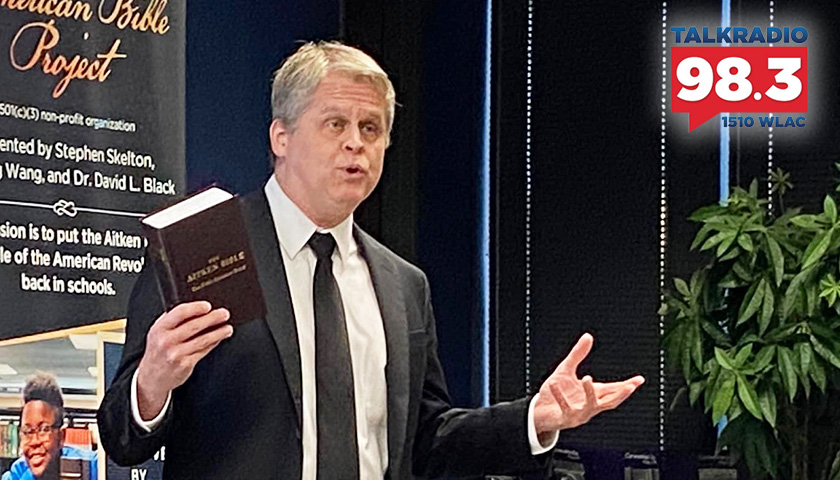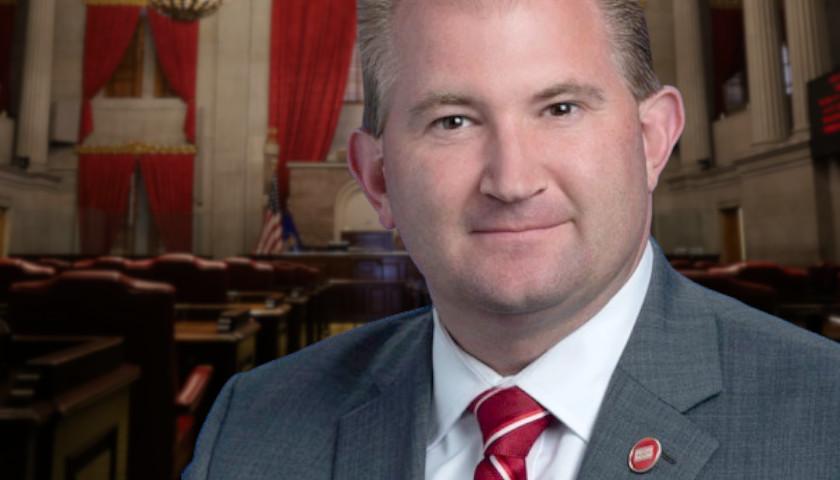Live from Music Row Monday morning on The Tennessee Star Report with Michael Patrick Leahy – broadcast on Nashville’s Talk Radio 98.3 and 1510 WLAC weekdays from 5:00 a.m. to 8:00 a.m. – host Leahy welcomed Stephen Skelton of The American Bible Project to the newsmaker line to offer a brief history of the first American Bible and how the organization is distributing them across the United States and into students’ hands.
Leahy: On our newsmaker line, Stephen Skeleton of The American Bible Project on the web at theamericanbible.org. Steven, delighted to have you on the program. You are teaming up with another friend of ours, Joni Bryant of the 917 Society.
That’s a nonprofit that donates pocket-sized Constitutions to 8th graders around the country and particularly here in Tennessee on Constitution Day, September 17th.
That’s the date that the Constitutional Convention in 1787 signed the Constitution and sent it to the states for ratification. Welcome, Stephen Skelton.
Skelton: Michael, thanks so much for having me this morning.
Leahy: So tell us about the event you are having tomorrow night in conjunction with the 917 Society. Your purpose is to put the Constitution in schools. How are you doing that?
Skelton: That’s right. So with the work through the 917 Society, it’s a nonprofit organization. It donates pocket-sized constitutions to 8th graders across the country for Constitution Day.
There’s a federal mandate for schools that receive federal funding to teach about the Constitution on Constitution Day. However, many schools can’t afford additional resources to celebrate Constitution Day.
And that is where the 917 Society comes in. So last year, they donated pocket-sized constitutions to one and a half million 8th graders across 14 states. It’s an awesome organization to support.
And this year the goal is even bigger for what they want to accomplish going forward. One and a half million students across 14 states and putting pocket-sized institutions into their hands is just the beginning. But as you said, Michael, for more information on the 917 Society, they can go to the website address: 917society.org.
Leahy: Now the other document that you’re putting back in schools is the first American bible. What is the first American bible? And are you running up into the whole church-state argument?
Skelton: No. In fact, our approach is completely historical, and that ties into what the first American bible is. So just a little bit of history: At the foundation of our nation when the American Revolution began, America stopped trade with Britain.
And when we stopped trade with Britain, among the many products that we stopped receiving from Britain were bibles, because it was the King James Version of the bible. And Britain was the only place that America got it from.
So as a result of that, we ran out of bibles in America. Stopped receiving them from Britain, and ran out of them in America. So a Philadelphia printer named Robert Aitken, he wrote a letter to the United States Congress and he asked for their approval to publish the first American bible [originally known as the Aitkin Bible, named for its publisher].
So this would be the first King James Bible made in America by Americans and for Americans. And to the shock of history, Congress said yes. On September 12, 1782, our founders in Congress issued a congressional resolution and they said two things.
The second thing was perhaps more shocking than the first. The first thing they said was Congress approved the printing of this first American Bible. So it became the only bible approved by Congress.
And the second thing they said was, and we recommend it to all Americans. So it then became not only the only bible approved by Congress but also the only bible recommended to Americans by our government. And it’s all about the history of that first American bible and how it ties into the teaching of the American Revolution.
Leahy: It is the King James Version printed and published in America, is that right?
Skelton: That’s exactly right.
Leahy: Now, how is this first American bible used in classrooms today? How do you get it into the classrooms and what kind of pushback do you get from the Lefties?
Skelton: We tied it into the teaching of the state academic standards. So that’s to say that the state academic standards are the roadmap for what teachers are teaching about the American Revolution.
And this is being used in connection to those academic standards as an object lesson. For example, the bible is going to go into the hands of the teachers that are teaching the American Revolution in fourth grade, in 8th grade, and in high school.
And educators are already teaching about the economic factors of the American Revolution. And when they teach about the embargo and the cessation of trade between America and Britain, they now have a physical resource they can present to the students.
They can say that this first American bible is an artifact of the embargo. And for the students, as they hold it in their hands, it helps to make the mental idea of the embargo and the products we stopped receiving, and the products that we created in America to replace those products that are more concrete, as they can actually hold in their hands this authentic reproduction of the only bible approved by Congress and the only bible recommended to American citizens by the American government.
And that’s just one example of how it’s being used. It actually ties into the state academic standards in five different ways: It’s the embargo, the economy, Congress, culture, and immigration. So for more information about what we’re doing with The American Bible Project, they can go to theamericanbible.org.
Leahy: How many of these first American bibles have been distributed and used in classrooms in K-12 public education and other private schools around the country?
Skelton: That’s right. Since we first began the distribution of putting this first American bible back into the hands of the teachers, they’re teaching the American Revolution and showing each individual state how it connects to their state academic standards, which is very important, so they have a map of how to use it.
We are now rolling up on 1,000 bibles back in 1,000 schools. And what that means is that we have found people that want to sponsor the schools in their community to put the bible back into schools. And those folks sponsor those schools and we send the bibles into the hands of the teachers teaching the American Revolution.
Leahy: So a typical school gets how many first American Bibles?
Skelton: You’ll have three? There are three bases to cover at each school. And that’s to say that there’s a first teacher that’s teaching the American Revolution, let’s say, in fourth grade; well, there’s also a second teacher that’s also teaching the American Revolution in fourth grade.
One teacher is handling approximately 25 students. The second teacher is also handling approximately 25 students, and they’re able to cycle through an entire class by going at it with two teachers covering the topic of the American Revolution.
The third bible actually goes into the library. So the student that goes up to the teacher and says, hey, I’ve never heard of the first American bible, I’d love to show that to my dad, my mom, my pastor, my youth pastor. Can I borrow this one from the class?
And the teacher says, well, that’s a class guest-room copy, but there’s one waiting in the library for you to go and check out. And so the third base we cover is to the students, through the library with that first American bible.
Listen to the interview:
– – –
Tune in weekdays from 5:00 – 8:00 a.m. to The Tennessee Star Report with Michael Patrick Leahy on Talk Radio 98.3 FM WLAC 1510. Listen online at iHeart Radio.





